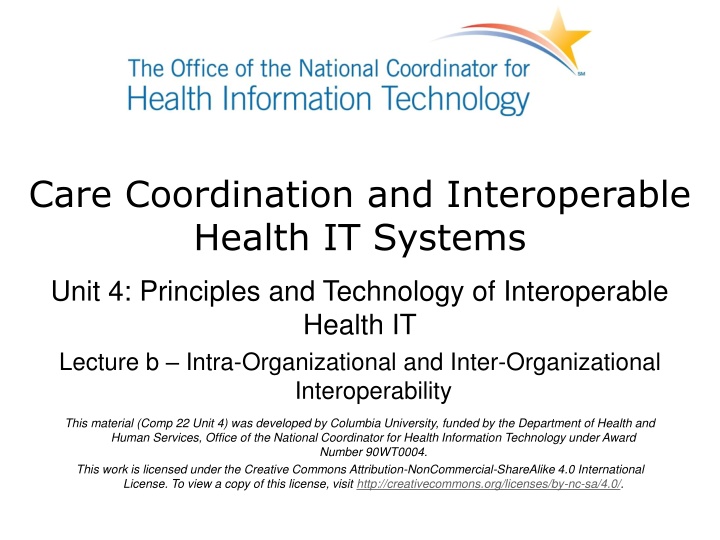
Principles of Intra-Organizational Interoperability in Healthcare IT
Explore the complexities of intra-organizational interoperability in healthcare IT systems, including data flow, ownership, and value sets within organizations. Learn about the importance of data ownership and how it impacts healthcare data management and interoperability solutions.
Download Presentation

Please find below an Image/Link to download the presentation.
The content on the website is provided AS IS for your information and personal use only. It may not be sold, licensed, or shared on other websites without obtaining consent from the author. If you encounter any issues during the download, it is possible that the publisher has removed the file from their server.
You are allowed to download the files provided on this website for personal or commercial use, subject to the condition that they are used lawfully. All files are the property of their respective owners.
The content on the website is provided AS IS for your information and personal use only. It may not be sold, licensed, or shared on other websites without obtaining consent from the author.
E N D
Presentation Transcript
Care Coordination and Interoperable Health IT Systems Unit 4: Principles and Technology of Interoperable Health IT Lecture b Intra-Organizational and Inter-Organizational Interoperability This material (Comp 22 Unit 4) was developed by Columbia University, funded by the Department of Health and Human Services, Office of the National Coordinator for Health Information Technology under Award Number 90WT0004. This work is licensed under the Creative Commons Attribution-NonCommercial-ShareAlike 4.0 International License. To view a copy of this license, visit http://creativecommons.org/licenses/by-nc-sa/4.0/.
Principles and Technology of Interoperable Health IT Learning Objectives Objective 1: Name and define types of interoperability (Lecture a) Objective 2: Explain the complexities of semantic harmonization and the benefits of using standards (Lecture a) Objective 3: Describe and contrast intra- and inter-organizational interoperability (Lecture b) Objective 4: Identify and discuss common types of tools and technologies used to solve health interoperability problems (Lecture c) 2
Typical intra-organizational data flow Transaction feed- based Downstream systems can remember context Limited scope of data 4.6 (Lorenzi, V., 2016) 3
Within an organization, you can usually establish single owners of data and value sets Patient administration system IDs: Patient ID, visit ID, provider ID Owns: Demographics, visit administrative data Value sets: Race, religion, gender, language, location, admit type Electronic health record IDs: Document IDs, order IDs Owns: Clinical notes, medication administration record, orders Value sets: Order sets, document types, order catalog Lab system IDs: Filler order ID, result ID, accession ID Owns: Filler order, result, specimen, charge Value sets: Lab order catalog, result catalog, specimen type Clinical data warehouse Aggregate data view 4
Why data ownership matters 4.7 Figure (Lorenzi, V., 2016) 4.8 Figure (Lorenzi, V., 2016) 5
Example of inter-organizational data flow 4.9 Figure (Lorenzi, V., 2016) 6
Inter-organizational interoperability patient matching Patient identification is difficult, but critical to locating patients records across organizations A community level enterprise master patient index (EMPI) is needed to link identifiers across organizations Provider ID matching and organization ID matching are needed as well There is a need to maintain the quality of this community level EMPI EMPI is covered in another lecture in this unit For more information on patient identification, see component 24, unit 5 For more information on health information exchange, see unit 8 7
Inter-organizational interoperability differences in terminologies Terminology differences are a barrier to communication across organizational boundaries Organizations have local terminologies It is difficult to compare terms across organizations There are variances in standards adoption There is a need for a community-level terminology service to map terms between organizations Terminology services are covered in another lecture in this unit 8
Inter-organizational interoperability governance and trust No clear authority No one in charge of changes or fixing problems Multiple data owners Competitive, not collaborative Tendency towards less data sharing There is a need for regulatory support and intermediaries to establish rules 9
Inter-organizational interoperability data flow Transaction-based feeds are not as appropriate Pull-based (request/response) Subscription-based feeds Receivers require more contextual information Intentional and official Document exchange is more common 10
Inter-organizational interoperability needs Widespread adoption of standards Less variance in standards Changes in financial models To make sharing a benefit and not a burden Changes in laws and policies To foster sharing while protecting, in particular the consumer, and holding accountable all parties Support structures to keep the sharing functioning Interlinked IT service desks Data quality reviewers Change management Upgrades and communication Changes in organization, process, and workflow So that health care stakeholders benefit and we have better care at lower costs 11
Unit 4: Principles and Technology of Interoperable Health IT, Summary Lecture b, Intra- Organizational and Inter-Organizational Interoperability Intra-organizational interoperability Exchange of information between systems in the same organizational context Single owners of data, clear patient identification, generous information sharing, and transaction-based feeds Inter-organizational interoperability Exchange of information across organizations Multiple conflicting data owners, multiple patient IDs, more formality in data sharing, pull-based and subscription-based feeds, and management challenges 12
Principles and Technology of Interoperable Health IT References Lecture b Charts, Tables, Figures 4.6 Figure: Lorenzi, V. (2016). Example of intra-organizational data flow. Used with permission. 4.7 Figure: Lorenzi, V. (2016). Why data ownership matters part 1. Used with permission. 4.8 Figure: Lorenzi, V. (2016). Why data ownership matters part 2. Used with permission. 4.9 Figure: Lorenzi, V. (2016). Example of inter-organizational data flow. Used with permission. 13
Unit 4: Principles and Technology of Interoperable Health IT, Lecture b Intra-organizational and inter- organizational interoperability This material was developed by Columbia University, funded by the Department of Health and Human Services, Office of the National Coordinator for Health Information Technology under Award Number 90WT0004. 14






















